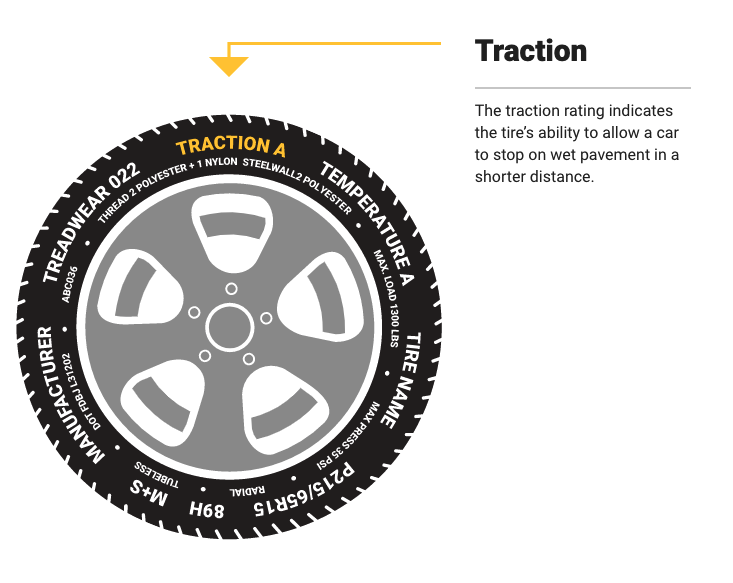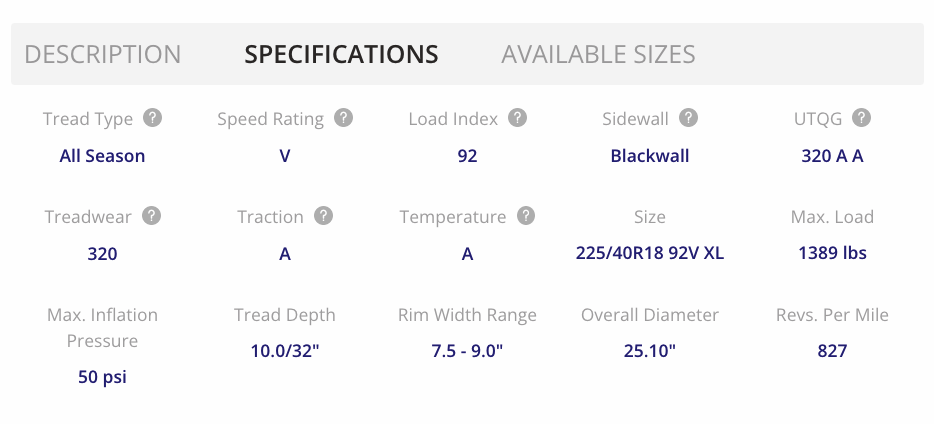Your Shopping Cart
Your cart is empty.
Subtotal ( items)
Instant Rebate Applied:
Promo Code Applied: ID.me Discount Applied:
Have a Promo Code?
Size:
Item
Item
Selected for:
/ each
Add-Ons
Wireless air pump capable of pumping up to 150 psi with 2000 MAH power bank.



Fully protect your clothes and vehicle interior during transportation of your tires. For Tires up to 31" tall and wheels up to 22".
Per sensor
Add TPMS Sensors
/per sensor
Please confirm the make, year, model and trim of the vehicle you want to purchase for:
How many sensors do you need?
The vehicle you have selected is not compatible with aftermarket TPMS Sensors.
Enter a different vehicle to add TPMS sensors

 Front Tire Size:
Front Tire Size:
 Rear Tire Size:
Rear Tire Size:
 Your Vehicle:
Your Vehicle:
Pros & Cons of Staggered Fitment

Attractive Design

Improved Handling

Improved Cornering
Bumpier Ride
Poor Traction in Snow
How do I find my tire size?



Need help?
 Your Vehicle:
Your Vehicle:
Pros & Cons of Staggered Fitment

Attractive Design

Improved Handling

Improved Cornering
Bumpier Ride
Poor Traction in Snow
How do I find my tire size?



Need help?
Pros & Cons of Staggered Fitment

Attractive Design

Improved Handling

Improved Cornering
Bumpier Ride
Poor Traction in Snow
Need help?
Need help?
How do I know if I have an LT tire?

 Your Vehicle:
Your Vehicle:
Sorry, we could not find any available
wheels for your sizing selections.
Need help?
Guide to Traction Rating on Passenger Tires
By Tire Agent Staff
October 27, 2021
Passenger tires in the United States are rated in ways that are intended to help tire buyers choose the best and safest tires for their vehicles. The tire industry is regulated by the US Department of Transportation’s National Highway Traffic Safety Administration (NHTSA).
The NHTSA developed the Uniform Tire Quality Grading system (UTQG), which is a government-defined standard for identifying three important tire qualities: treadwear, temperature and traction.
Treadwear refers to the durability of a tire and how well its tread held up during a 7,200-mile test against a government tire. We explain treadwear in this guide to tire treadwear ratings.
Temperature refers to a tire’s ability to resist heat. We explain tire temperature ratings in a separate post.
What Does Tire Traction Rating Mean
Tire traction scores refer to a tire’s ability to stop on wet pavement. The higher the rating, the shorter the stopping distance. Tires are rated AA, A, B and C where AA is the highest grade or shorter stopping distance and C is the lowest grade and longest stopping distance.
Some people look at the UTQG traction rating as a tire quality grade rating, and to some extent that is a fair way to look at traction ratings. Ultra-high performance tires, which are engineered for high performance sports cars, tend to have the highest AA traction rating. Why? Because these vehicles tend to be driven at higher speeds, and drivers tend to stop shorter. So, a high performance sports car driver might prefer a AA traction rating that has a better grip on wet roads.
Is tire traction the same as tire grip rating? Yes, that’s what tire traction rating means. Traction and grip both refer to the ability of a tire to stop, especially on wet surfaces. Traction ratings are based on how tires perform during extreme testing conditions on wet surfaces.
Tire Traction Rating Chart
Tire traction ratings charts can get pretty complicated, especially when the experts include things like asphalt G-force and concrete G-force. G force refers to gravitational force or, in terms of driving, it refers to acceleration. Honestly, there’s no need for the average vehicle owner and tire shopper to understand the math and science behind G force, other than to know that the higher the rating, the “safer” the tire is and the shorter its stopping distance is expected to be.
|
Traction Grade |
What Does It Mean? |
% of Tires Sold in US |
Asphalt G-Force |
Concrete G-Force |
|
AA |
Best |
15% |
Above .54 |
.38 |
|
A |
Better |
77% |
Above .47 |
.35 |
|
B |
Good |
7% |
Above .38 |
.26 |
|
C |
Poor |
<1%* |
Less Than .38 |
.26 |
*The NHTSA says only 4 brand/makes of tires are rated C.
A tire traction rating of “A” is the most common tire grip score. The NHTSA estimates that more than three-fourths of all tires sold here are traction rated A.
How to Use Tire Traction to Buy Tires
A tire’s wet grip rating is based on the tire’s condition when it is new. This is important to understand:
- As tires age, their tread wears down, and so does their traction.
- Tires that aren’t properly inflated, rotated and aligned will wear down faster.
- The more wear a tire has, the longer its expected stopping distance will be.
The best traction tires are usually ultra high performance tires; however, most vehicles and drivers do not need AA rated tires. For day-to-day driving on North American roads, tires rated A for traction suffice.
How to Find Tire Traction Ratings
On your tire’s outer side wall, look for the TREADWEAR, TRACTION AND TEMPERATURE markings. If you do not see them on the outer side wall, use Tire Agent’s tire brand search tool to find the make, model and size of your tire.
You can also visit the NHTSA’s tire ratings lookup tool to find details about the various makes and models of passenger vehicle tires.
Any time you have a question about the best tire for your car, speak to a Tire Agent customer service representative. Email, call or use our live chat feature to ask questions.
Tire Agent is your online tire shop, where shipping is always free, financing is always just a few clicks away, and all in-stock tires are shipped within a few business days.
Sources:
Next Post:
Guide to Tire Treadwear RatingsHow to Qualify for the $50 Offer
- Add items to your cart and begin checkout.
- Select PayPair and apply for financing.
- If you’re approved by a participating lender, you’ll see a $50 promotional rebate applied to your order total.
-
To receive the $50, you must:
- Complete your purchase with a qualifying lender,
- Agree to the payment terms,
- And make the required number of consecutive on-time payments, as specified by the lender.
Note: Offer available only through select lenders. Additional eligibility requirements and conditions apply. Rebate may be issued after verification of qualifying payment activity. Terms subject to change.
How to Purchase Tires and Wheels
With a Payment Plan
Tire Agent's payment plans make it easy to get the best partial or full set of tires and wheels for your vehicle.
It's fast, secure and won't affect your credit score
Match with multiple lenders
Why Choose PayPair?
PayPair’s Partners and Plans

No Money Down

No Money Down

No Credit Needed*

No Money Down

$1 to Start!*

No Money Down

No Credit Needed*

$1 to Start!*

No Money Down
Other Payment Plans

$0 to Little Down

Pay with your bank account

Simplified checkout experience

Faster and easier than using cards or cash

Simplified checkout experience

Faster and easier than using cards or cash
*SNAP: The advertised service is a lease-to-own agreement provided by Snap RTO LLC. Lease-to-own financing is not available to residents of Minnesota, New Jersey and Wisconsin. NO CREDIT NEEDED: Not all applicants are approved. While no credit history is required, Snap obtains information from consumer reporting agencies in connection with applications, and your score with those agencies may be affected. PAYMENT PLAN: The standard plan consists of renewable lease terms. To exercise an early ownership, consumers must make regular payments on time and schedule additional payments via the customer portal or by contacting Customer Care at 1-877-557-3769. KATAPULT: The Promotional Initial Payment (plus any applicable taxes and fees) is due at lease signing. Your lease-purchase payment amount will be determined after you select your product(s). You will not acquire ownership of the product(s) if the total amount necessary to acquire ownership is not paid. The Promotional Initial Payment does not reduce the cost of the lease-purchase agreement. The Promotional Initial Payment is only available when shopping at Tire Agent through the Katapult mobile app and at Tire Agent’s website. Product pricing subject to change and availability. Disclosure: 90-day early purchase option (EPO) terms and conditions apply: 90-Day (3 months in CA) You can buy out your lease-to-own agreement within the first 90-days. This amount includes the cash price, plus the lease-to-own cost for the first 90-days. Taking advantage of the 90-day purchase option will save you the most money! PROGRESSIVE: Ownership by rental/lease agreement with Progressive Leasing costs more than the retailer’s cash price. Select items only. Cancel or purchase early at any time. Not available in MN, NJ, VT, WI, WY. Progressive Leasing obtains information from credit bureaus. Not all applicants are approved. Standard agreement offers 12 months to ownership. 90-day purchase options cost more than the retailer’s cash price (except 3-month option in CA). To purchase early or to cancel lease, you must call 877-898-1970. Retailer cannot activate early purchase options.


